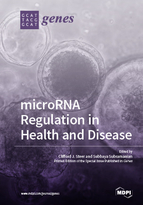microRNA Regulation in Health and Disease
A special issue of Genes (ISSN 2073-4425). This special issue belongs to the section "Molecular Genetics and Genomics".
Deadline for manuscript submissions: closed (31 January 2019) | Viewed by 42552
Special Issue Editors
Interests: receptor-mediated delivery; liver regeneration; microRNA biogenesis; genome editing
Special Issues, Collections and Topics in MDPI journals
Interests: colorectal cancer; tumor immunology; T cells; immune cells; microbiome
Special Issues, Collections and Topics in MDPI journals
Special Issue Information
Dear Colleagues,
microRNAs (miRNAs) are small regulatory RNAs that play a crucial role in posttranscriptional gene regulation. Over two thousand miRNAs have been identified in humans, and many of them are conserved in other species. miRNAs are implicated in fundamental cellular functions including development and disease. In the last decade, there has been an overwhelming understanding of miRNA biogenesis and their target genes. Further, there is a significant amount of work carried out in developing miRNA biomarkers and therapeutics for various disease conditions. RNA based markers and therapeutics have proved to have a clinical impact, and many of these miRNA-based therapies are at various stages of human clinical trial and clinical applications. Notably, miRNAs are also found in exosomes and are considered to impart intercellular communication and function via several different modalities including tunneling nanotubes. In spite of our understanding of miRNA biology and function, there are many challenges in effectively using miRNAs as biomarkers and therapeutic agents in clinical applications.
In this Special Issue, we are inviting reviews, perspectives, and original research articles to address some of these challenges. Topics will include, but not limited to, miRNA biogenesis, clinical applications, extracellular function, biomarkers, miRNA immune regulation, signaling pathways, and preclinical models.
Prof. Dr. Clifford Steer
Dr. Subree Subramanian
Guest Editors
Manuscript Submission Information
Manuscripts should be submitted online at www.mdpi.com by registering and logging in to this website. Once you are registered, click here to go to the submission form. Manuscripts can be submitted until the deadline. All submissions that pass pre-check are peer-reviewed. Accepted papers will be published continuously in the journal (as soon as accepted) and will be listed together on the special issue website. Research articles, review articles as well as short communications are invited. For planned papers, a title and short abstract (about 100 words) can be sent to the Editorial Office for announcement on this website.
Submitted manuscripts should not have been published previously, nor be under consideration for publication elsewhere (except conference proceedings papers). All manuscripts are thoroughly refereed through a single-blind peer-review process. A guide for authors and other relevant information for submission of manuscripts is available on the Instructions for Authors page. Genes is an international peer-reviewed open access monthly journal published by MDPI.
Please visit the Instructions for Authors page before submitting a manuscript. The Article Processing Charge (APC) for publication in this open access journal is 2600 CHF (Swiss Francs). Submitted papers should be well formatted and use good English. Authors may use MDPI's English editing service prior to publication or during author revisions.
Keywords
- miRNA
- cancer
- development
- immune response
- intercellular communication biomarkers
- therapeutics








